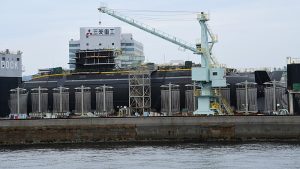On September 15, the United States, United Kingdom, and Australia jointly announced the Australia-U.K.-U.S. (AUKUS) trilateral security partnership with a focus on Indo-Pacific region. Aimed at fostering “deeper integration of security and defense-related science, technology, industrial bases, and supply chains,” AUKUS will begin their cooperation in earnest by launching the development of Australia’s nuclear-powered submarine as its inaugural cooperative acquisition program over the next 18 months.
The announcement not only surprised many but also resulted in an deep diplomatic tensions between the U.S. and France as well as Australia and France – so much so that France decided to recall its ambassadors in Washington, D.C. and Canberra back to Paris for consultations. urthermore, despite the in-person Quad summit in Washington, D.C. on September 24, where U.S. President Joe Biden met with his Australia, Indian, and Japanese counterparts, the White House unambiguously ruled out the possibility of either India or Japan joining AUKUS, raising a question of how the AUKUS partnership can be mutually reinforcing with the other minilateral relations — the Quad as well as trilateral groupings like Australia-Japan-U.S., India-Japan-U.S., and Japan-South Korea-U.S., to name a few — that have been blossoming in the Indo-Pacific region between the U.S. and its allies and partners.
If the leaders in Tokyo are surprised by Washington’s apparent unwillingness to expand AUKUS to include Japan, they shouldn’t be. An AUKUS-like partnership that cuts across various industrial sectors relevant for national security is only possible when the countries that are involved already have a history of deep security cooperation, including intelligence sharing, and have mutual confidence in safeguarding the sensitive information that will be exchanged among them as part of the process of developing cooperative programs. Given that the U.S., U.K., and Australia enjoy a long-standing security relationship not only as allies but also as “Five Eyes” partners, the level of confidence that is required for a cooperative arrangement at this depth already exists among the three.
Despite the enthusiasm among those who are tasked with managing the Japan-U.S. alliance regarding bilateral defense relations, Japan, at the end of the day, has not reached a level of depth in its alliance relationship with the U.S. that is on par with the U.K. and Australia alliance. In fact, the lack of speed in modernizing Japanese systems to safeguard technology and information critical to national security, as well as the Japanese defense industry’s reluctance to go beyond its familiar frameworks of “indigenous development” and “license production” as the primary business models, have been hindering the deepening of defense industrial cooperation between the two countries. Despite a 2014 decision by the Abe cabinet to overhaul Japan’s arms export principles to provide Japanese defense industry with room to be more active in international markets, there has been little concrete progress in the seven years since.
Instead of lamenting that Japan has been “left out,” the leaders in Japan’s defense establishment should take this as an opportunity to consider what it would take for Japan to pursue a similar arrangement with the United States and its allies and partners, including the U.K. and Australia. For instance, given the level of institutionalization of Tokyo’s defense relationship with Australia, a U.S.-Japan-Australia cooperative framework in defense technology may not be a bridge too far. Better yet, leveraging the rising enthusiasm about the potential for Quad-based cooperation, Japan can propose to work closely with the U.S. and Australia to look for ways to create a similar security cooperation framework among the Quad partners.
In order for Japan to put itself in a position to initiate such a discussion, however, many aspects of the current culture that surrounds Japan’s defense industry need to change. In fact, with even the defense industry increasingly globalized – as the major acquisition programs are moving more and more toward leveraging multilateral cooperation – change may be the only way for the Japanese defense industry to survive.
































